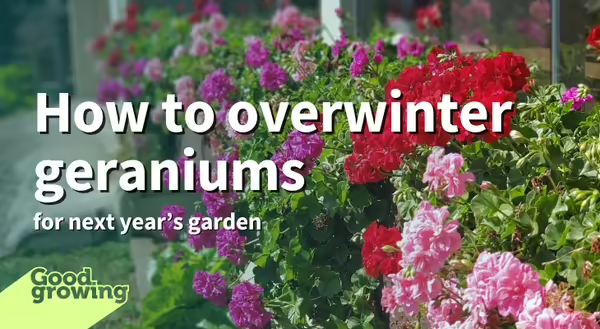
Annual geraniums (Pelargonium) are among the most popular flowering plants grown in gardens. These easy-to-grow, low-maintenance plants provide color to landscapes from May until the arrival of frost. After the first hard frost, they are typically destined for the compost pile, but that doesn’t have to be their fate. While they are often treated as annuals, they can be successfully overwintered indoors to be enjoyed again next year.
Preparing geraniums for overwintering
Geraniums must be dug or moved indoors before the first frost, so don’t wait until the last minute. Before bringing your geraniums indoors, inspect them for pests and diseases. Diseased plants, or those infested with insects, will be difficult to overwinter, and you run the risk of the disease or pests spreading to other plants. Discard any plants with spots/discoloration on leaves and stems, wilting/shriveled or rotting, or infested with insects.
Once you’ve selected the plants you wish to keep, you’ll need to decide to overwinter them. This can be done by growing them as houseplants, storing them as bare-root plants, or taking cuttings.
Overwintering geraniums as potted/house plants
Geraniums can be overwintered indoors as houseplants. This is particularly easy if they are already being grown in pots, but plants that are in the ground can also be overwintered this way. Carefully dig plants, place them in an appropriately sized pot with drainage holes, prune them back by one-third to one-half, and thoroughly water them.
Treat potted geraniums like other houseplants and place them in a bright, sunny window or provide supplemental lighting. They will do best when daytime temperatures are around 65°F, with nighttime temperatures slightly cooler. They will become lanky when grown in warm conditions and not given enough light. Pots should be watered when the growing media becomes dry. Plants can be pinched back occasionally to produce well-branched, stocky plants.
Storing geraniums as dormant bare root plants
When storing geraniums as bare root plants, dig them from the ground or remove them from their pots and remove the soil/potting media from their roots. Put plants in a large paper bag and place it in a cool (45-50°F), dry location. Alternatively, some people will hang their plants upside down.
While plants are being stored, most leaves will fall off the plants, and branch tips may die back. Come March, remove the plants from storage. Plants should be cut back to firm, green tissue and then planted in pots and cared for like other houseplants until they can be placed outdoors (May).
Taking geranium cuttings
Geraniums can also be overwintered as cuttings. Use a sharp knife or pruning shears to take 3-to 4-inch cuttings from the ends of branches (terminal shoots). Remove the lower leaves and dip the cut end into rooting hormone. Then, stick the cuttings into a pot (with drainage holes) with rooting media like perlite, vermiculite, or a sand-peat moss mixture and water.
Make sure the growing media remains moist so the cuttings don’t dry out. A plastic bag (clear) can be placed over the pot to help retain moisture, but make sure to monitor for mold growth. Plants should then be placed under bright lights.
It can take anywhere from 4-8 weeks for plants to root. Once the cuttings have rooted, they can be placed into 3- to 4-inch pots and grown indoors until being brought outdoors.


Good Growing Fact of the Week: Annual geraniums aren’t “true” geraniums; they are members of the genus Pelargonium, while true geraniums, like wild geranium, are in the genus Geranium.
Want to get notified when new Good Growing posts are available? SIGN UP HERE!
Give us feedback! How helpful was this information (click one): Very helpful | Somewhat helpful | Not very helpful
MEET THE AUTHOR
Ken Johnson is a Horticulture Educator with University of Illinois Extension, serving Calhoun, Cass, Greene, Morgan, and Scott counties since 2013. Ken provides horticulture programming with an emphasis on fruit and vegetable production, pest management, and beneficial insects. Through his programming, he aims to increase backyard food production and foster a greater appreciation of insects.